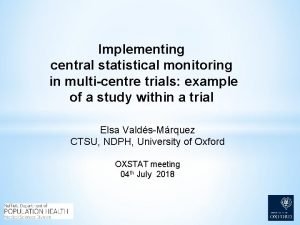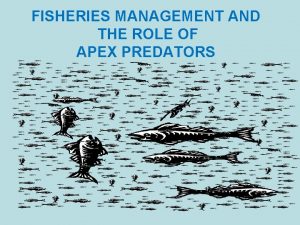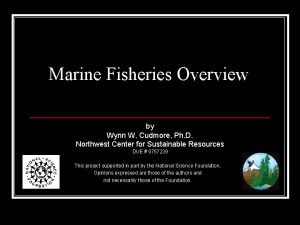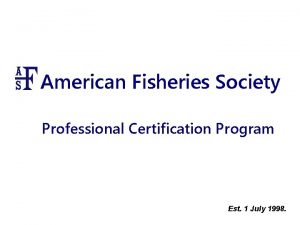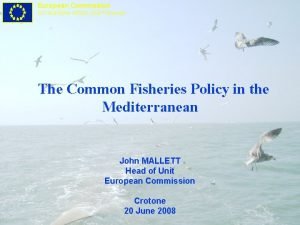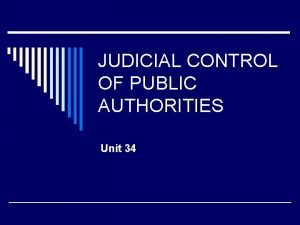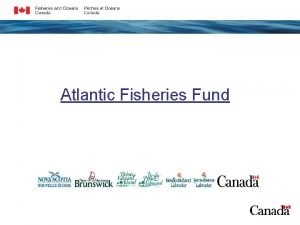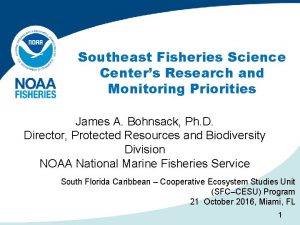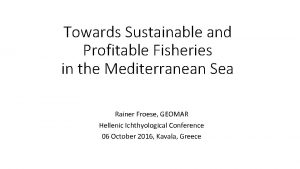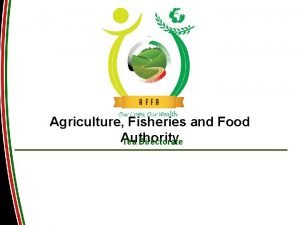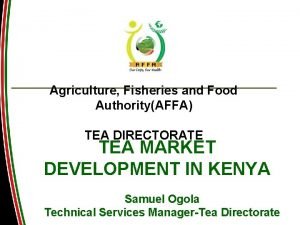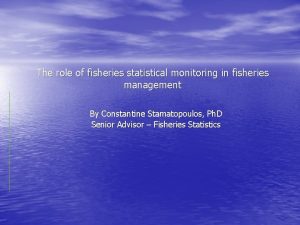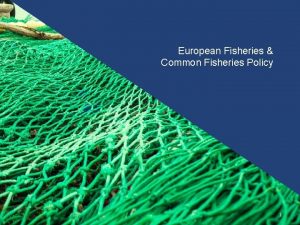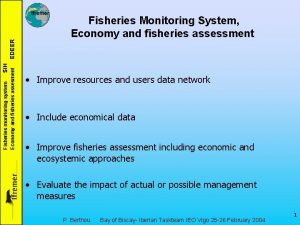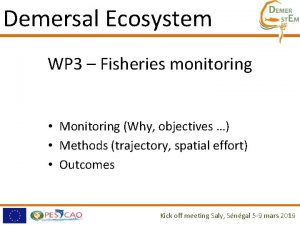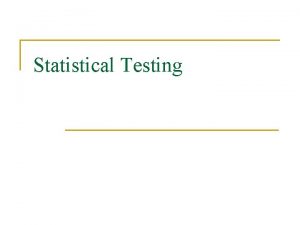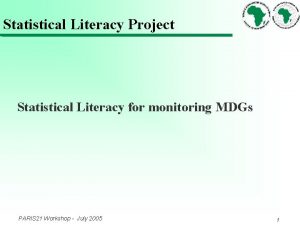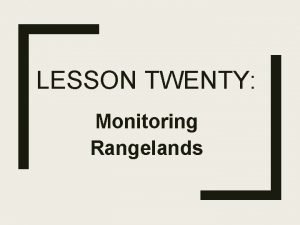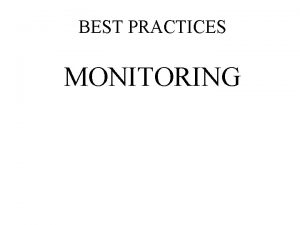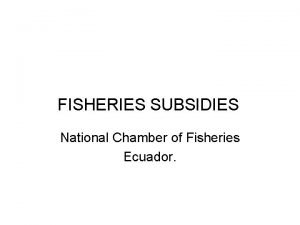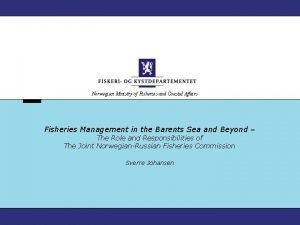The role of fisheries statistical monitoring in fisheries




























- Slides: 28

The role of fisheries statistical monitoring in fisheries management By Constantine Stamatopoulos, Ph. D Senior Advisor – Fisheries Statistics

Topics 1. Fisheries Statistics in Fisheries Management 2. Fisheries Statistical Monitoring 3. Design aspects 4. Implementation aspects 5. Discussion

TOPIC 1 Fisheries Management and Fisheries Statistics

1. Fisheries Management Why fisheries statistics in needed • Fishery resources are renewable but not infinite and their exploitation should be monitored. • A depleted stock may recover very slowly or never. Statistical indicators contribute in the understanding of the state of stocks. • Need to understand the impact of fishing activities to the ecosystem and vice versa. Combined information from interrelated systems allow for relevant analytical studies. • Food security aspects. Catches and imports constitute primary variables in understanding the contribution of fisheries in food security. • Socio-economic aspects. Fishermen are generally considered a less privileged community. Socio-economic studies make extensive use of catch/effort data. • Contribution to the national economy. Prices and values.

1. Fisheries Management and fisheries statistics Examples of services and functions • Indicators concerning biodiversity and relative abundance • Combination with environmental and other indicators • Biological and economic models • Advice to authorities by means of scientifically-based evidence

1. Fisheries Management and fisheries statistics FIRST CONCLUSION A Fisheries statistical monitoring programme is not an end in itself but it serves a wide variety of applications that are part of fisheries management and planning

1. Fisheries Management and fisheries statistics Statistical monitoring is exercised through: • Collection of timely and reliable statistical data on a routine basis • Formulation of meaningful statistical intelligence • Appropriate biological and socio-economic studies

1. Fisheries Management and fisheries statistics Regional Action Plans • The regional community has become increasingly concerned on environmental issues, particularly in the fisheries sector. • First major step was the adoption of the Code of Conduct for Responsible Fisheries (CCRF). • CCRF followed by RECOFI initiatives (ongoing) for improving the knowledge on status and trends of capture fisheries. • Several regional and national statistical development studies have been implemented over the last ten years.

TOPIC 2 Fisheries Statistical Monitoring

2. Fisheries Statistical Monitoring • The implementation of the Code of Conduct requires, among others, the best possible scientific evidence concerning the status of stocks and trends of fisheries. • Regional studies on resource exploitation require that in each country there is in place an effective statistical programme and that national programmes, though independent and autonomous, are capable of contributing to a harmonized integration of basic data at aggregate level. • The availability of timely and reliable data constitutes a continuing need. • Catch and fishing effort are indispensable for any type of basic statistical analysis. • Fisheries change dynamically and their monitoring requires continuing data collection programmes

2. Fisheries Statistical Monitoring Routine data collection of data is related to: • Fishing vessels. • Fishing gear and fishing methods. • Distribution of fishing fleet. • Catch. • Fishing effort. • Fish size. • Prices.

2. Fisheries Statistical Monitoring ARTISANAL FISHERIES • Implementation of census-based approaches for setting-up registers of fishing vessels • Seasonal distribution of fishing fleet (by port and fishing gear) • Stratification of the geographical area and establishment of statistical entities (month, geographical area, boat/gear type) • Design and implementation of sample-based data collection programmes for catch, fishing effort, fish size and prices • Formulation of reliable estimates of fishing effort, fish production, values and average fish size for each statistical entity • Basic and advanced statistical analyses

2. Fisheries Statistical Monitoring INDUSTRIAL FISHERIES • Implementation of data flow mechanisms for maintaining vessel registers and licensing systems. • Inclusion in the fishing permit processes of clauses obliging companies and operators to submit detailed information on fishing activities. • Design and implementation of logbooks or landing declaration procedures. • Implementation of a database system for the storage and processing of data. • Production of statistics on fleet capacity, fishing effort, fish production, values and average fish size for each fleet segment. • Basic and advanced statistical analyses

TOPIC 3 Design Aspects of Statistical Monitoring Programmes for Artisanal Fisheries

3. Design aspects Reasons for implementing sample-based catch/effort surveys • Small-scale fisheries may involve thousands of fishing units scattered along the coastline. • It is generally accepted that complete enumeration of all fishing operations (monitoring through census in space and time) is impractical. 15

3. Design aspects Spatial and temporal considerations - Home ports are distinguished from landing sites. - Fishing effort is measured at HOME PORTS. - Catch details are collected at LANDING SITES. - But a place can be a HOMEPORT as well as a LANDING SITE. - Typical components of an estimation context: A calendar month, a geographical stratum and a homogeneous group of boats and gears and/or fishing methods (Operational Unit – OU). 16

3. Design aspects Typical functions of a sample-based fisheries statistical set of utilities Maintaining statistical standards and classifications (species, gears, strata, etc. ) Maintaining vessel records or sampling frames 9/25/2020 Inputting of sample data on production and effort Reports on primary data Reports on estimated data Editing and storage services for primary sample data. Integration of data from various fisheries Estimation of catch and effort Data diffusion 17

TOPIC 4 Implementation Aspects

4. Implementation 1. 2. 3. 4. 5. 6. Rapid boat census aiming at setting up accurate boat counts by homeport and boat/gear category. The level of detail in boat/gear will determine the gear classification in the catch/effort surveys (point for discussion). Selection of most suitable data collection scenarios for landings and fishing effort. These may differ for different areas and/or different boat/gear types. Design of data collection forms and training of data collectors on their purpose and use. Testing period. Revisions and eventual corrections. Full-scale implementation and computerization. 19

Observations

Fisheries are seldom static. They are evolving. They thus require flexible, modular and adaptable statistical monitoring programmes

Efficient systems are those that can take advantage of acquired knowledge and interpret it into statistical interventions that will reduce the level of uncertainty of estimations

Statistical systems for artisanal fisheries require an adequate infrastructure, knowledgeable staff, cost-effective data collection schemes and good database design

Controlling system accuracy

Increased utility

Standardized methodology

Advanced statistical methods in controlling accuracy

END Thank you for your kind attention
 Central statistical monitoring
Central statistical monitoring Role taking krappmann
Role taking krappmann Statuses and their related roles determine
Statuses and their related roles determine Azure worker role
Azure worker role Northwest fisheries
Northwest fisheries Tiger shark torpedo
Tiger shark torpedo Wilson v brobbey 1974
Wilson v brobbey 1974 Biological productivity definition
Biological productivity definition Small-scale fisheries
Small-scale fisheries Ministry of food agriculture and fisheries denmark
Ministry of food agriculture and fisheries denmark Fish harvesting methods
Fish harvesting methods Fisheries management
Fisheries management Certified fisheries professional
Certified fisheries professional Alaska fisheries development foundation
Alaska fisheries development foundation Dg maritime affairs and fisheries
Dg maritime affairs and fisheries Allingham v minister of agriculture and fisheries
Allingham v minister of agriculture and fisheries Ocean fisheries
Ocean fisheries Institute of oceanography and fisheries
Institute of oceanography and fisheries Atlantic fisheries fund
Atlantic fisheries fund Southeast fisheries science center
Southeast fisheries science center General fisheries commission for the mediterranean
General fisheries commission for the mediterranean Agriculture fisheries and food authority
Agriculture fisheries and food authority Boat security system
Boat security system Mifco logo
Mifco logo Pearson prentice hall
Pearson prentice hall сплит institute of oceanography and fisheries
сплит institute of oceanography and fisheries Agriculture fisheries and food authority
Agriculture fisheries and food authority National fisheries service
National fisheries service V. c c
V. c c
